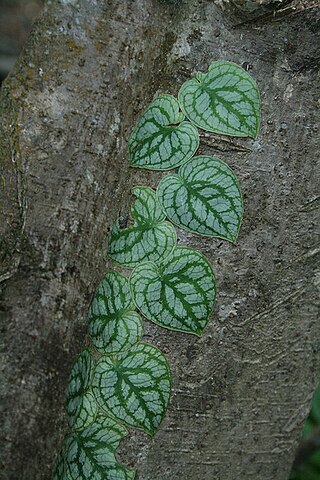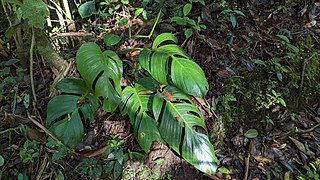
The Araceae are a family of monocotyledonous flowering plants in which flowers are borne on a type of inflorescence called a spadix. The spadix is usually accompanied by, and sometimes partially enclosed in, a spathe. Also known as the arum family, members are often colloquially known as aroids. This family of 114 genera and about 3,750 known species is most diverse in the New World tropics, although also distributed in the Old World tropics and northern temperate regions.

Monstera is a genus of 59 species of flowering plants in the arum family, Araceae, native to tropical regions of the Americas.

Monstera dubia is a species of plant in the genus Monstera native to Central and South America. M. dubia is known for the dramatic transformation its foliage makes as it climbs from seed stage on the forest floor, to shingling closely up a host tree trunk or other surface, until mature leaves with fenestrations similar to Monstera deliciosa appear. This transformation is an example of leaf dimorphism. Dubia refers to dubious, because authors were not certain that the species fell within the genus Marcgravia, where it was initially placed.

Monstera obliqua is a species of the genus Monstera native to Central and South America. It is hemiepiphytic like most other Monstera species. The plant is particularly known for its foliage, which is often highly perforated, sometimes described as having more empty space than leaf. An illustration of the general variation in adult leaf shape from different individuals of this species can be found in Michael Madison's A Revision of Monstera. The species is not commonly cultivated, but the name is often misapplied to specimens of the more widespread Monstera adansonii.
Monstera tacanaensis is a species of flowering plant in the genus Monstera of the arum family, Araceae.

Monstera pinnatipartita is a species of flowering plant in the genus Monstera native to Central America and the tropical areas of South America. Like the more common Monstera deliciosa the plant has green foliage that becomes highly fenestrated when mature, though both immature and mature leaves are less heart shaped. Its name refers to the deeply split mature leaves that are pinnate.
Monstera amargalensis is a flowering plant that belongs to the genus Monstera, and the family Araceae.
Monstera dissecta is a species of flowering plant in the genus Monstera and family Araceae.

Monstera filamentosa is a flowering plant in the genus Monstera and family Araceae.

Monstera glaucescens is a flowering plant in genus Monstera of the arum family, Araceae.The native range of this species is Nicaragua to Colombia. It is a climber that grows primarily in wet tropical biomes.
Monstera guzmanjacobiae is a species of plant in the family Araceae from Mexico.
Monstera integrifolia is a species of flowering plant in the genus Monstera in the arum family, Araceae.

Monstera lechleriana is a flowering plant in the genus Monstera in the arum family, Araceae. It is native to Bolivia, Colombia, Ecuador, Panamá, Peru, and Venezuela. The species is named for the German botanist Willibald Lechler, who collected the original type specimen in 1854. It was the scientifically described by Heinrich Wilhelm Schott by 1860. Like other Monstera, the plant is an epiphytic climbing vine which grows on the lower trunks of trees, and which produces large leaves with leaf windows when mature that appear on each side of the midrib of the foliage.
Monstera luteynii is a species of flowering plant in the genus Monstera of the arum family, Araceae.
Monstera maderaverde is a species of flowering plant in the genus Monstera in the arum family, Araceae. Its native range is Honduras.

Monstera membranacea is a species of flowering plant in the genus Monstera of the arum family, Araceae.
Monstera molinae is a species of flowering plant in the genus Monstera in the arum family, Araceae.

Monstera monteverdensis is a species of flowering plant in the arum family, Araceae. Its adult form is characterized by pinnatifid margins with up to eight lobes per side, with occasional fenestrations away from the midrib. Leaves can grow as large as 60 cm long and 30 cm wide. It is named after the city of Monteverde, where the species is abundant.
Monstera subpinnata is a species of flowering plant native to Bolivia, Peru, Ecuador and Colombia. It grows as an epiphyte. The plant is best known for its pinnate leaves, which are unusual within the genus Monstera. The species can grow as tall as 12 m, with leaves growing as large as 40 cm long and 30 cm wide.

Monstera tuberculata, also called the giant Monstera or the giant velvet-leaf Monstera, is a species of plant in the genus Monstera native from Mexico south to Panama. It grows in lowland wet tropical biomes up to 200 metres (660 ft) in elevation. Similar to Monstera dubia and a few other species in its genus, when young M. tuberculata has a shingle-like growth habit with leaves tightly pressed against the trunks of trees. As it matures, it has short-stemmed, oval leaves that lack the fenestrations of better-known species like Monstera deliciosa. Unusually for an aroid, its fruit hangs like a pendant.










